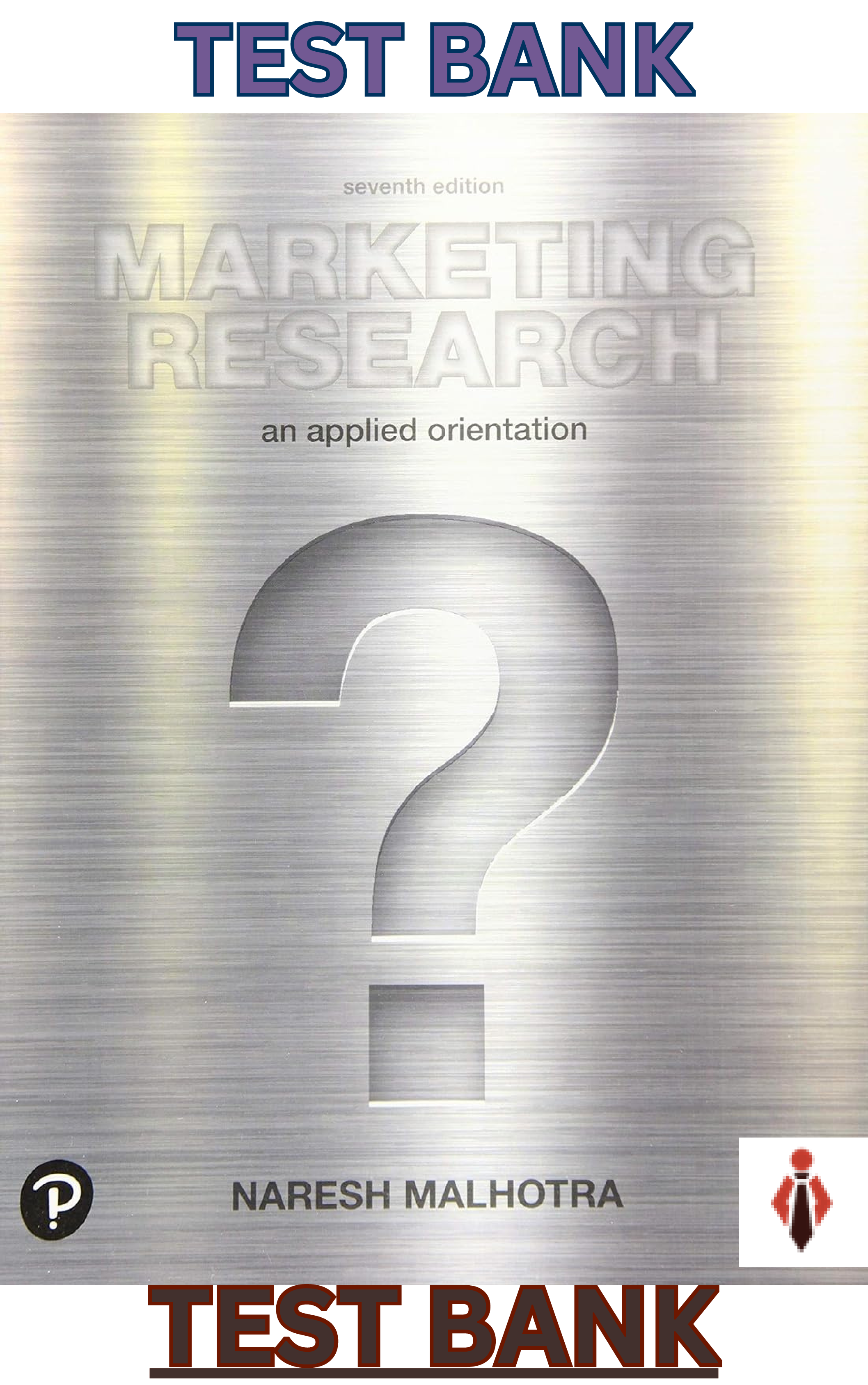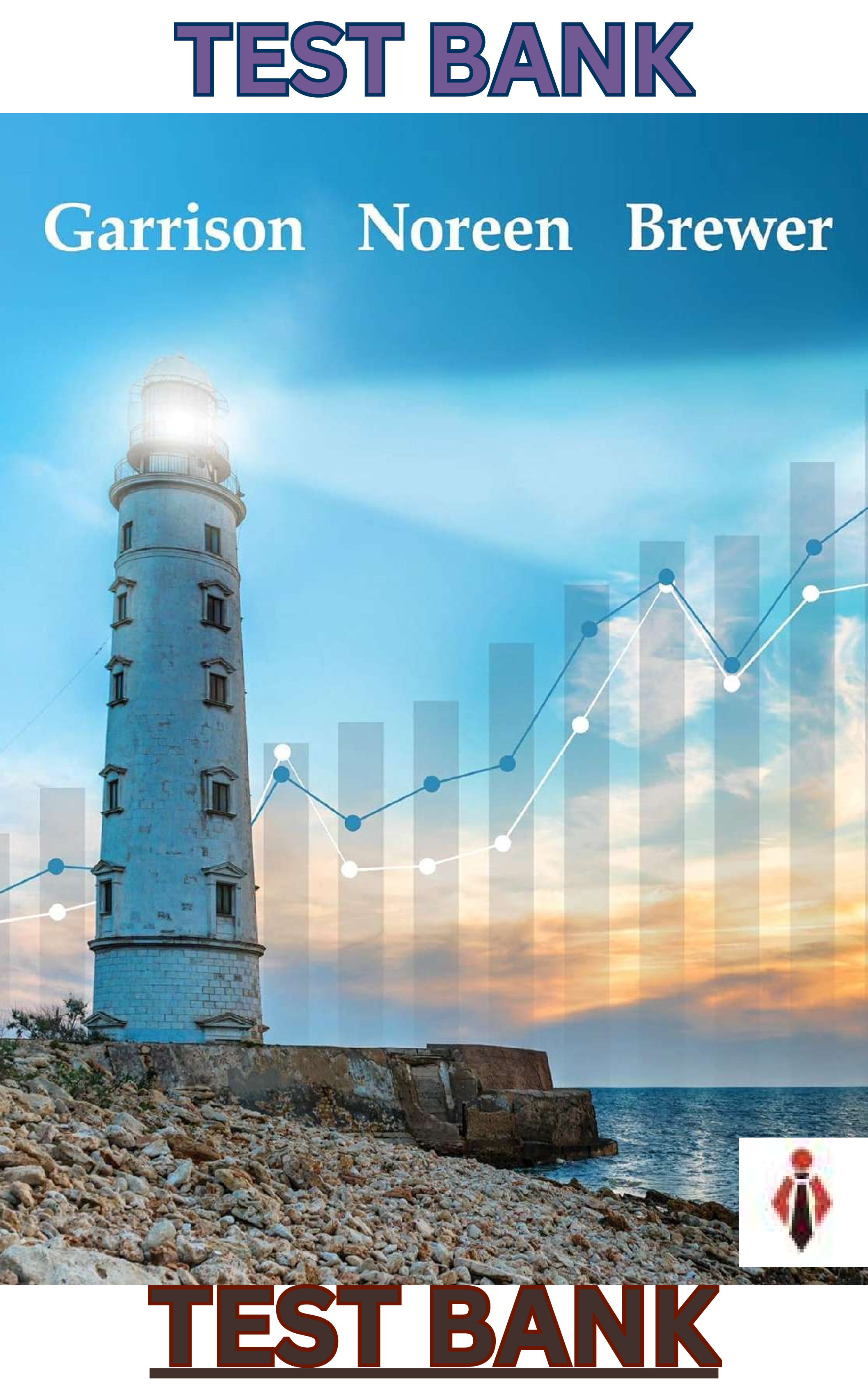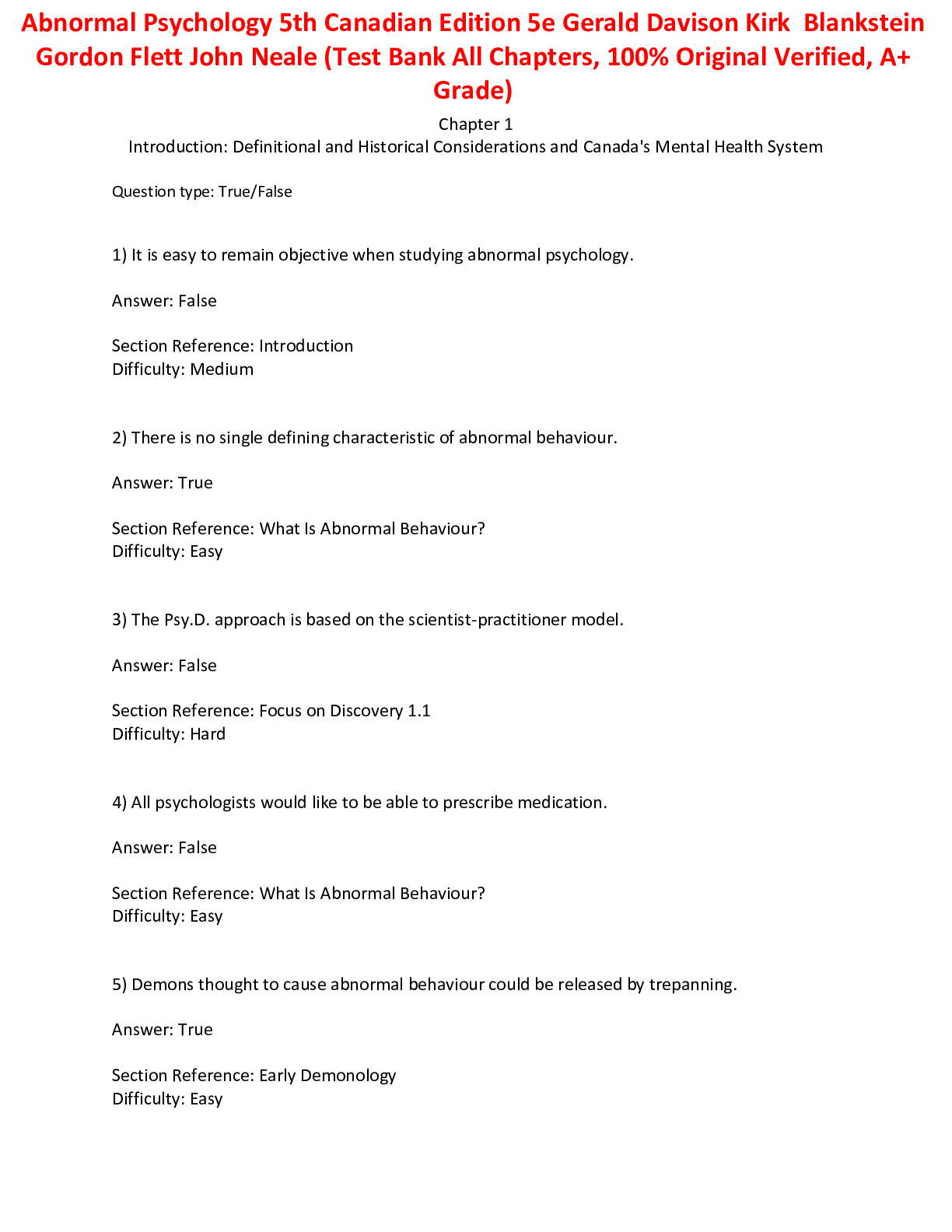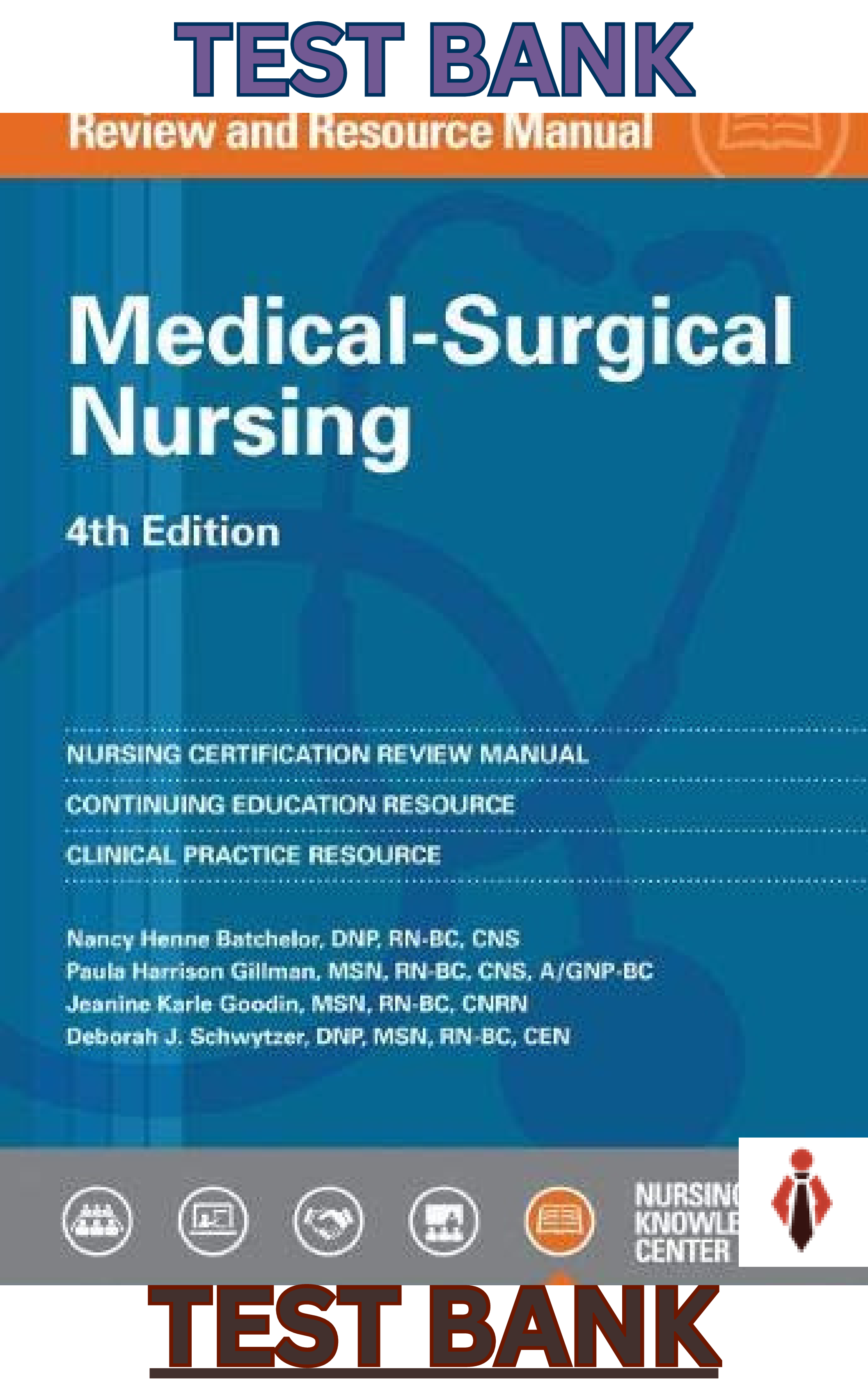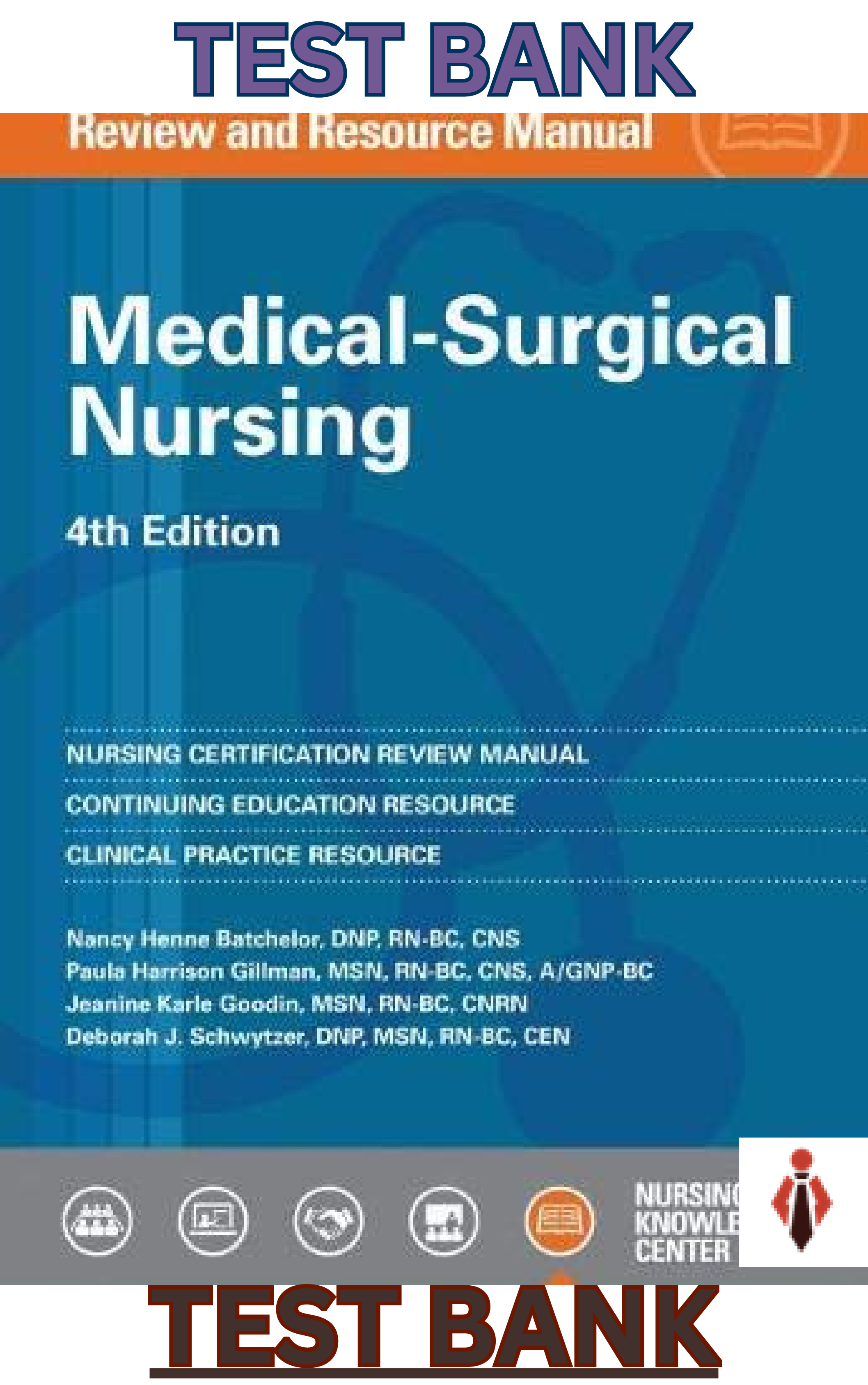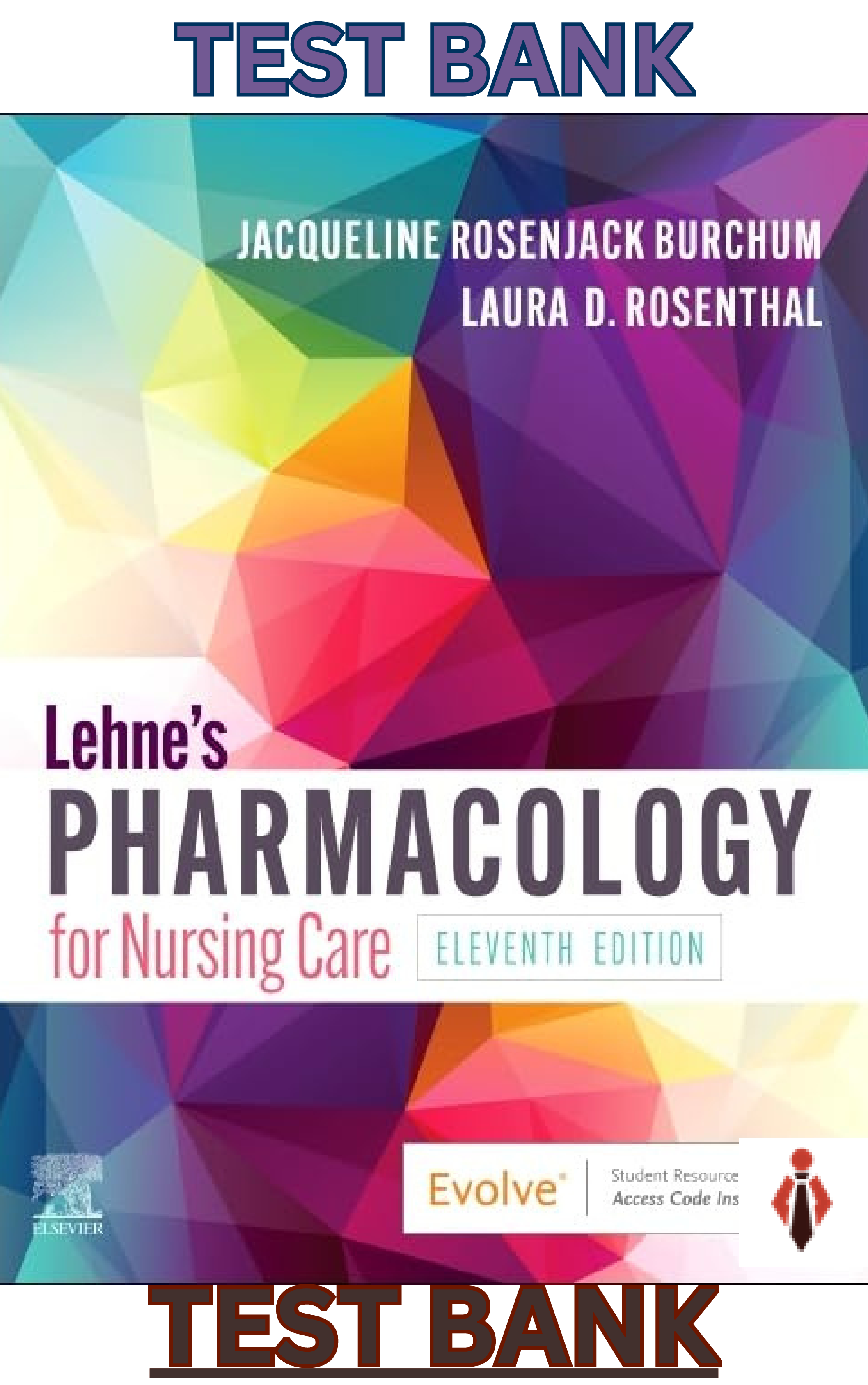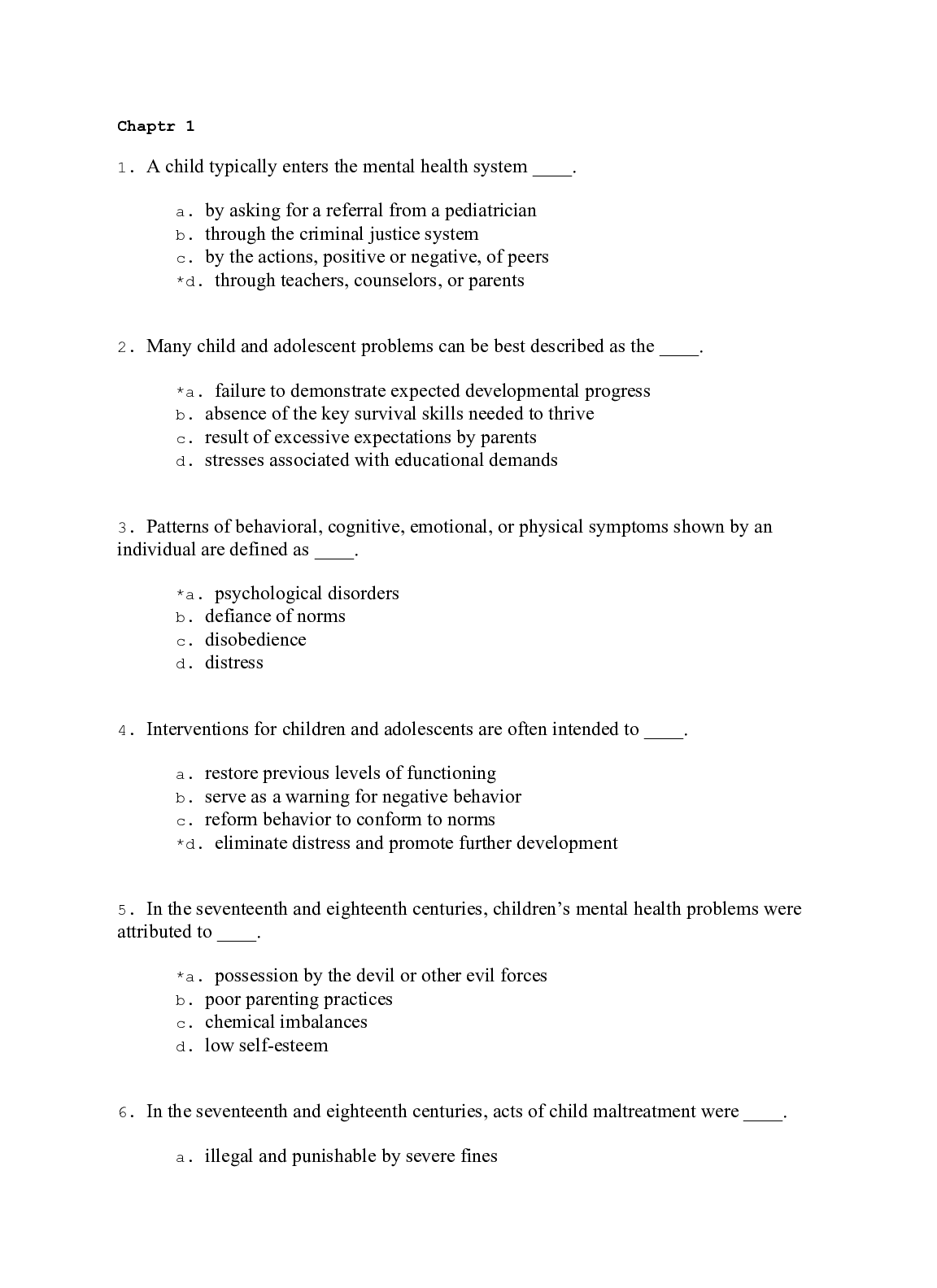*NURSING > TEST BANK > TEST BANK FOR A Manual of Laboratory and Diagnostic Tests 7th edition Frances T Fischbach (All)
TEST BANK FOR A Manual of Laboratory and Diagnostic Tests 7th edition Frances T Fischbach
Document Content and Description Below
Diagnostic Testing 1 OVERVIEW OF THE CLINICIAN'S ROLE: RESPONSIBILITIES, STANDARDS, AND REQUISITE KNOWLEDGE Education Alert Chart 1.1 Grading Guidelines for Scientific Evidence Chart 1.2 Basics o... f Informed Care PRETEST PHASE: ELEMENTS OF SAFE, EFFECTIVE, INFORMED CARE Basic Knowledge and Necessary Skills Testing Environments History and Assessment Reimbursement for Diagnostic Services Chart 1.3 Tests Covered by Most Insurance Carriers Methodology of Testing Interfering Factors Avoiding Errors Proper Preparation Patient Education Testing Protocols Patient Independence Test Results Laboratory Reports Margins of Error Ethics and the Law Patient's Bill of Rights and Patient Responsibilities Cultural Sensitivity INTRATEST PHASE: ELEMENTS OF SAFE, EFFECTIVE, INFORMED CARE Basic Knowledge and Required Skills Infection Control NOTE Collaborative Approaches Risk Management Specimens and Procedures Equipment and Supplies Family Presence Positioning for Procedures Administration of Drugs and Solutions Management of Environment Pain Control, Comfort Measures, and Patient Monitoring POSTTEST PHASE: ELEMENTS OF SAFE, EFFECTIVE, INFORMED CARE Basic Knowledge and Necessary Skills Abnormal Test Results Clinical Alert Follow-Up Counseling Monitoring for Complications Test Result Availability Clinical Alert Referral and Treatment Follow-Up Care Documentation, Record Keeping, and Reporting Chart 1.4 Diseases and Conditions Reportable by Health Care Providers and Others Chart 1.5 Diseases and Conditions Reportable by Laboratory Directors Guidelines for Disclosure Patient Responses to Expected or Unexpected Outcomes Expected and Unexpected Outcomes IMPORTANCE OF COMMUNICATION CONCLUSION BIBLIOGRAPHY OVERVIEW OF THE CLINICIAN'S ROLE: RESPONSIBILITIES, STANDARDS, AND REQUISITE KNOWLEDGE In this era of high technology, health care delivery involves many different disciplines and specialties. Consequently, clinicians must have an understanding and working knowledge of modalities other than their own area of expertise. This includes diagnostic evaluation and diagnostic services. Laboratory and diagnostic tests are tools to gain additional information about the patient. By themselves, these tests are not therapeutic; however, when used in conjunction with a thorough history and physical examination, these tests may confirm a diagnosis or provide valuable information about a patient's status and response to therapy that may not be apparent from the history and physical examination alone. Generally, a tiered approach to selecting tests is used: Basic screening (frequently used with wellness groups and case finding) Establishing (initial) diagnoses Differential diagnosis Evaluating current medical case management and outcomes Evaluating disease severity Monitoring course of illness and response to treatment Group and panel testing Regularly scheduled screening tests as part of ongoing care Testing related to specific events, certain signs and symptoms, or other exceptional situations (eg, infection and inflammation [bladder infection or cellulitis], sexual assault, drug screening, pheochromocytoma, postmortem tests, to name a few) ( Table 1.1) Table 1.1 Examples of Selecting Tests Diagnostic Test Indication Stool occult blood Yearly screening after 45 years of age Serum potassium Yearly in patients on diuretic agents or potassium supplements; in cases of some cardiac arrhythmias Liver enzyme levels Monitoring patient on hepatotoxic drugs; establish baseline values Serum amylase In the presence of abdominal pain, suspect pancreatitis Thyroid-stimulating hormone (TSH) test Suspicion of hypothyroidism, hyperthyroidism, or thyroid dysfunction, 50 years of age and older Chlamydia and gonorrhea In sexually active persons with multiple partners to monitor for pelvic inflammatory disease Hematocrit and hemoglobin Baseline study; abnormal bleeding; detection of anemia (use CBC results if they are recent) Papanicolaou cervical smear (Pap) Yearly for all women = 18 years of age; more often with high-risk factors (eg, dysplasia, human immunodeficiency virus [HIV], herpes simplex) now checks for human papillomavirus (HPV), chlamydia, and gonorrhea, using DNA Urine culture Pyuria Syphilis serum fluorescent treponemal antibody (FTA) test Positive rapid plasma reagin (RPR) test result Tuberculosis (TB) skin test Easiest test to use for TB screening of individuals < 35 years of age or those with history of negative TB skin tests, for persons in resident homes Fasting blood glucose (FBG) Every 3 years starting at 45 years of age; monitor diabetes control Urinalysis (UA) Signs or history of recurrent urinary tract disease; pregnant women; men with prostatic hypertrophy Prothrombin time (PT) (INR) Monitoring anticoagulant treatment Prostate-specific antigen (PSA) and digital rectal examination Screen men = 50 years of age for prostate cancer yearly Chest x-ray Monitor for lung lesions and infiltrates; congestive heart failure; anatomic deformities, posttrauma, before surgery, follow-up for positive TB skin test and monitor treatment Mammogram Screen by 40 years of age in women, then every 12–18 months between 40 and 49 years of age, annually = 50 years of age; follow-up for history and treatment of breast cancer; routine screening when strong family history of breast carcinoma Colon x-rays and proctosigmoidoscopy Computed tomography (CT) scans DNA testing of hair, blood, skin tissue, or semen samples Screen adults for colon cancer beginning at age 45; follow up for presence of hemoglobin- or guaiac-positive stools, polyps, diverticulosis Before and after treatment for certain cancers, injuries, illness (eg, suspected transient ischemic attack, cerebro-vascular accident; diagnostic evaluation of certain signs/symptoms) To gather postmortem evidence, in certain criminal cases; to establish identity and parentage Some tests are mandated by government agencies or clinical practice guidelines of professional societies; others are deemed part of necessary care based on the individual practitioner's judgment and expertise or a group practitioner consensus. There is not a consensus as to the frequency of testing (eg, annually or after a certain age). Test selections are based on subjective clinical judgment. Often diagnostic tests or procedures are used as predictors of surgical risk and/or morbidity and mortality rates (eg, maximum oxygen consumption determination to assess risk before esophageal cancer surgery) as the risk may outweigh the benefit. Use of evidence-based guidelines for scheduling, selecting, retaining, or eliminating certain diagnostic tests may help in more effective case management and cost containment. These guidelines use a system that grades the quality of scientific evidence based on published reports of clinical trials, expert consensus, or clinical expertise. Levels of evidence are A to C and E, with A being the best evidence and E referring to expert opinion or consensus ( Chart 1.1). Education Alert Not all information on the Internet is reliable. Chart 1.1 Grading Guidelines for Scientific Evidence Clear evidence from all appropriately A. Measure plasma glucose through an accredited lab to diagnose conducted trials or screen for diabetes Supportive evidence from well-conducted B. Draw fasting blood plasma specimens for glucose analysis studies or registries No published evidence; or only case, C. Self-monitoring of blood glucose may help to achieve better observational, or historical evidence control Expert consensus or clinical experience or D. Measure ketones in urine or blood to monitor and diagnose Internet polls diabetic ketoacidosis (DKA) (in home or clinic) As an integral part of their practice, clinicians have long supported patients and their significant others in meeting the demands and challenges incumbent in the simplest to the most complex diagnostic testing. This testing begins before birth and frequently continues after death. The clinician who provides diagnostic services must have basic requisite knowledge to plan patient care and an understanding of psychoneuroimmunology (effects of stress on health status), must make careful judgments, and must gather vital information about the patient and the testing process, to diagnose appropriately within the parameters of the clinician's professional standards ( Table 1.2; Chart 1.2). Table 1.2 Examples of Inappropriate Tests and Replacement Tests Inappropriate Replacement Prostatic acid phosphatase PSA or free PSA Ammonia AST, GGT Crossmatch (needed if blood is actually to be given) Type and screen Calcium Ionized calcium CBC Hemogram HCV antibody HCV RNA by PCR Iron Ferritin Lupus cell ANA Creatinine Urea CRP ESR PSA, prostate-specific antigen; AST, aspartate transaminase; GGT, gamma-glutamyltransferase; CBC, complete blood count; HCV, hepatitis C virus; PCP, polymerase chain reaction; ANA, antinuclear antibody; CRP, C-reactive protein; ESR, erythrocyte sedimentation rate. Chart 1.2 Basics of Informed Care Manage testing environment using collaborative approach Communicate effectively and clearly Prepare the patient properly Follow standards Consider culture, gender, and age diversity Measure and evaluate outcomes; modify treatment as necessary Manage effective diagnostic services using team approach Interpret, treat, monitor, and counsel about abnormal test outcomes Maintain proper test records The diagnostic testing model incorporates three phases: pretest, intratest, and posttest ( Fig. 1.1). The clinical team actively interacts with the patient and his or her significant others throughout each phase. The following components are included with each laboratory or diagnostic test in this text:...........................continued [Show More]
Last updated: 1 year ago
Preview 1 out of 771 pages
.png)
Reviews( 1 )

by Shunling.Tan · 2 years ago
Document information
Connected school, study & course
About the document
Uploaded On
Oct 17, 2021
Number of pages
771
Written in
Additional information
This document has been written for:
Uploaded
Oct 17, 2021
Downloads
1
Views
142

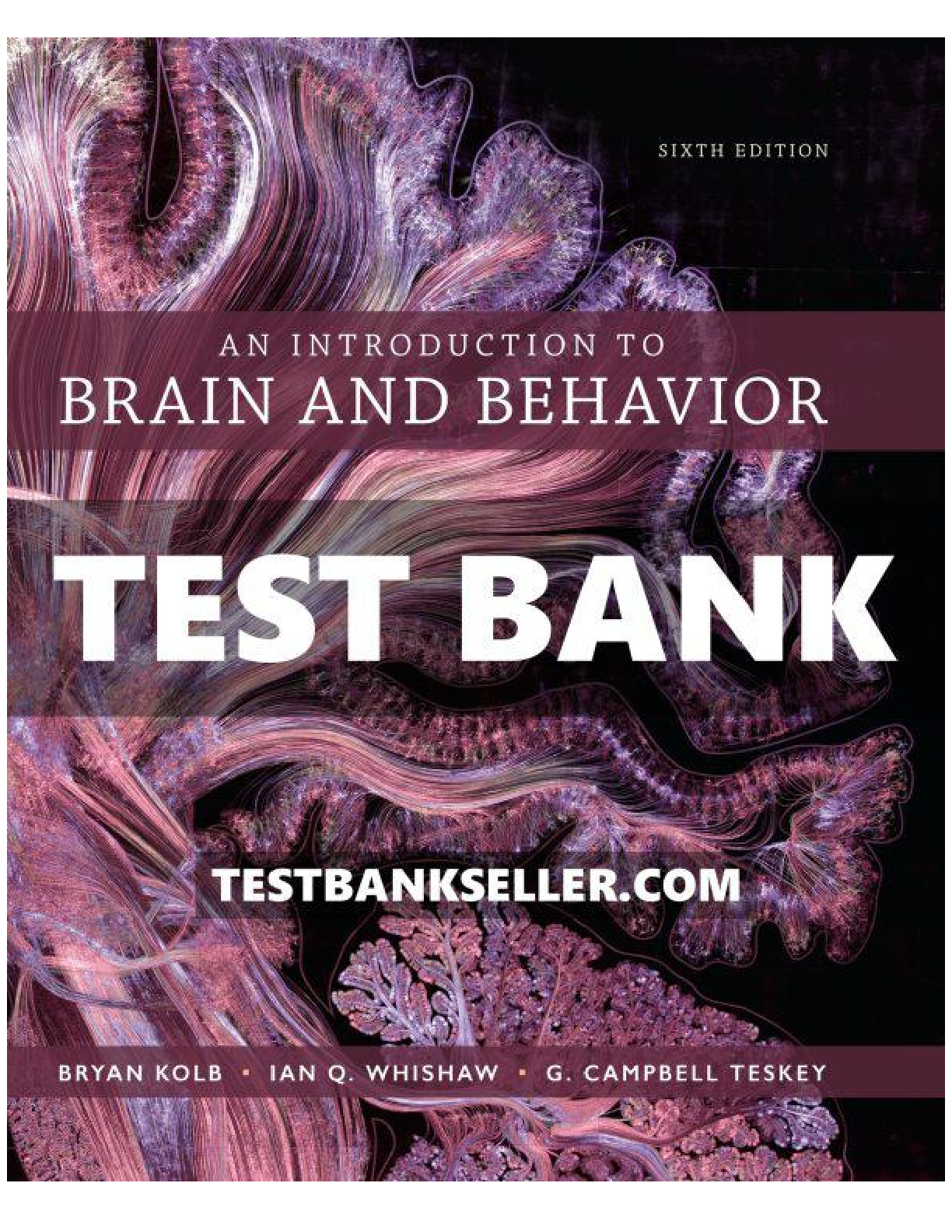
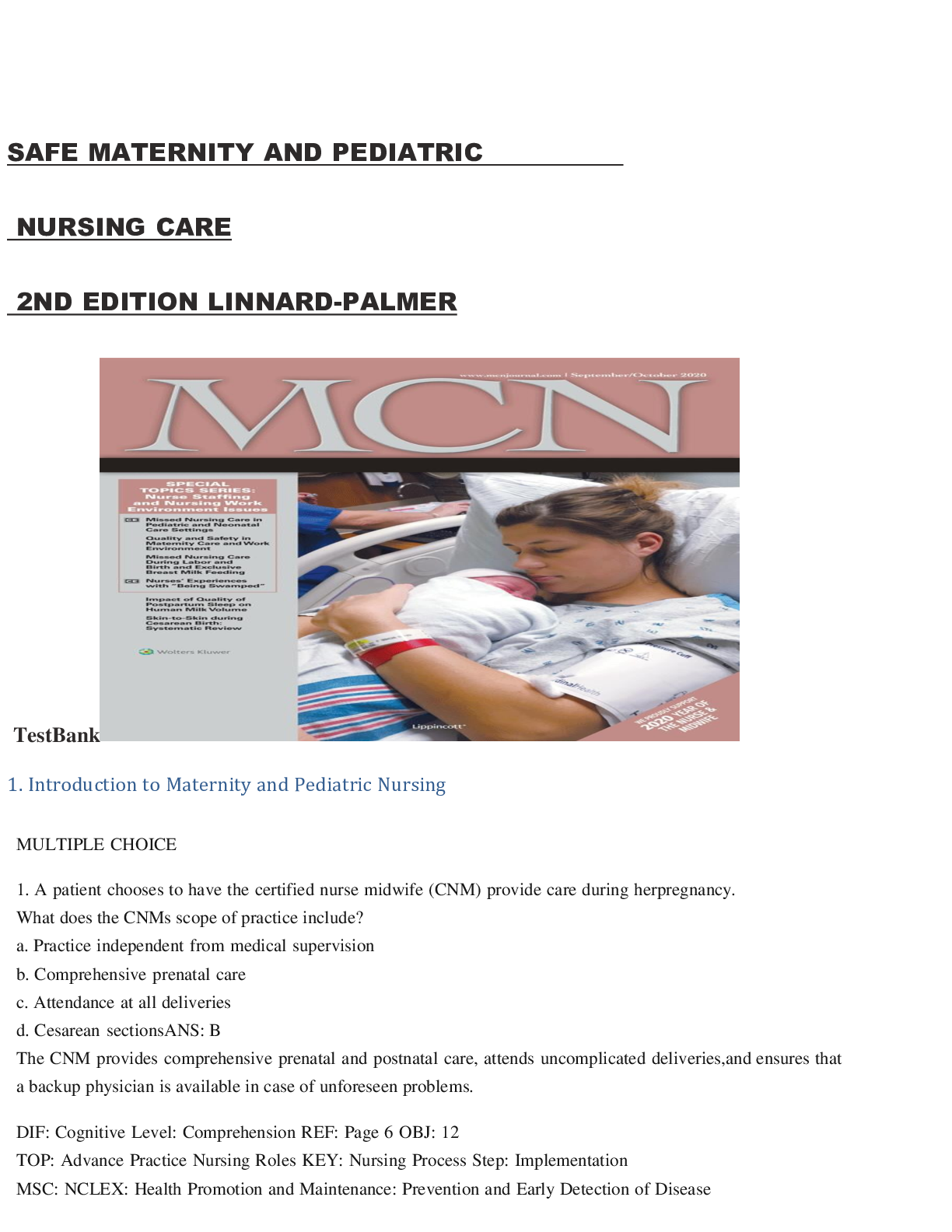
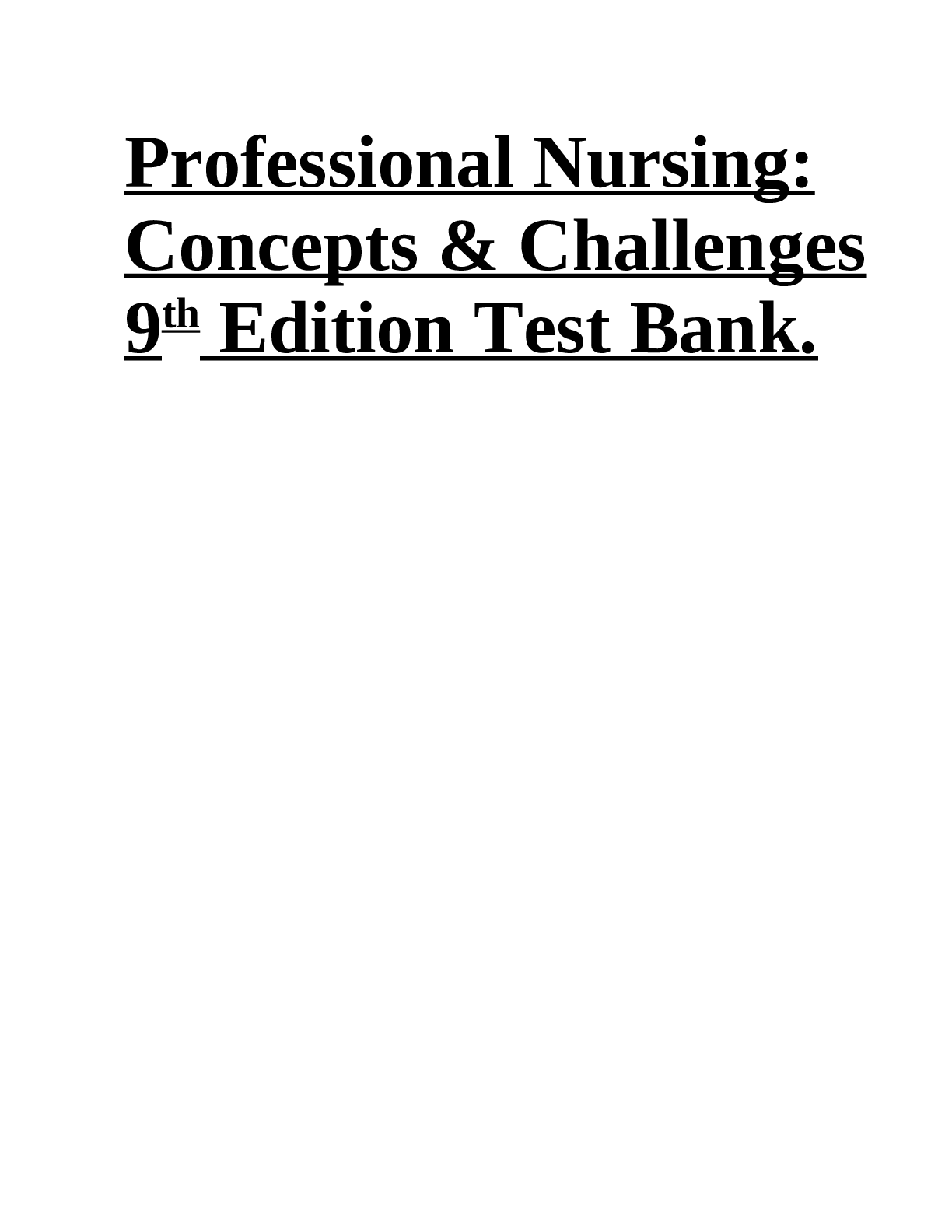

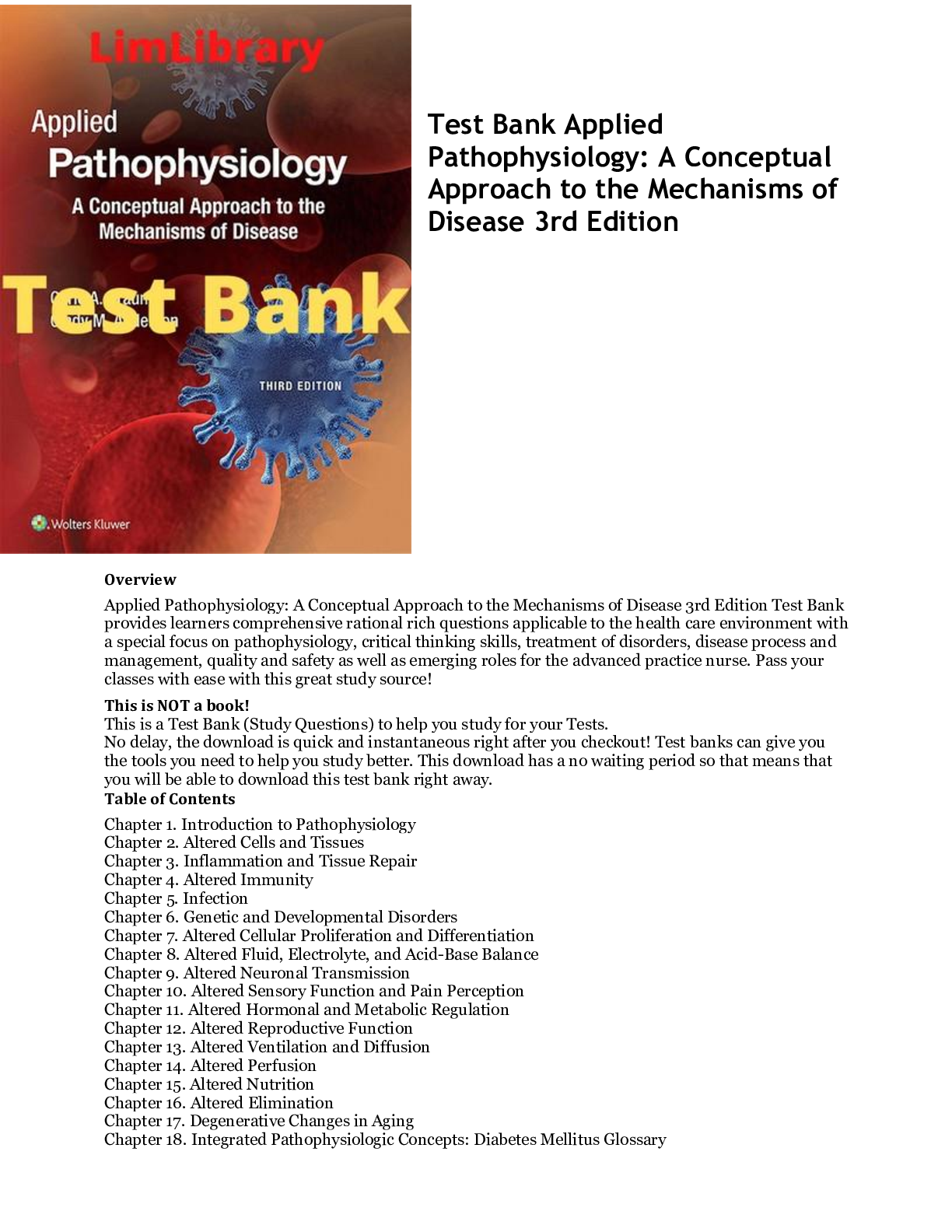

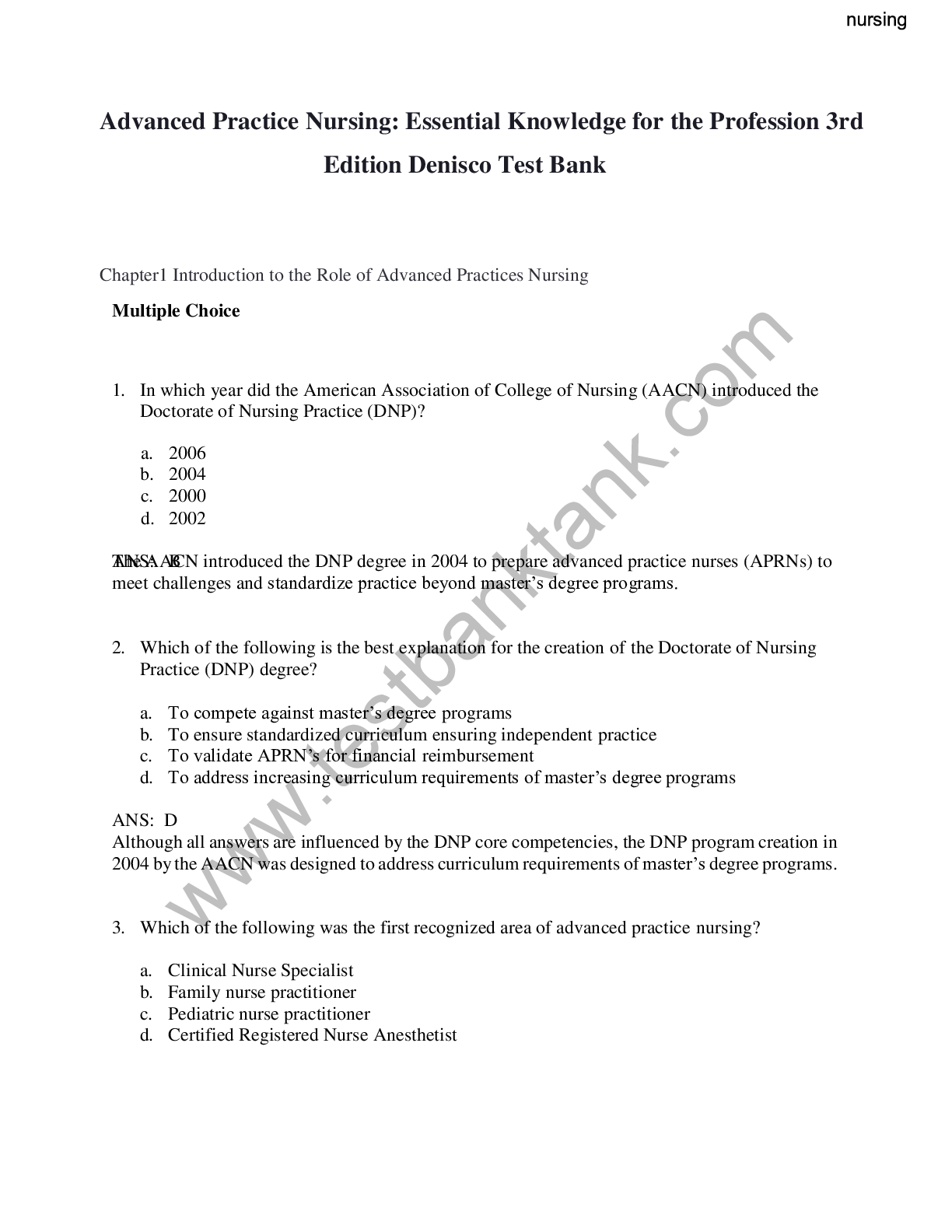
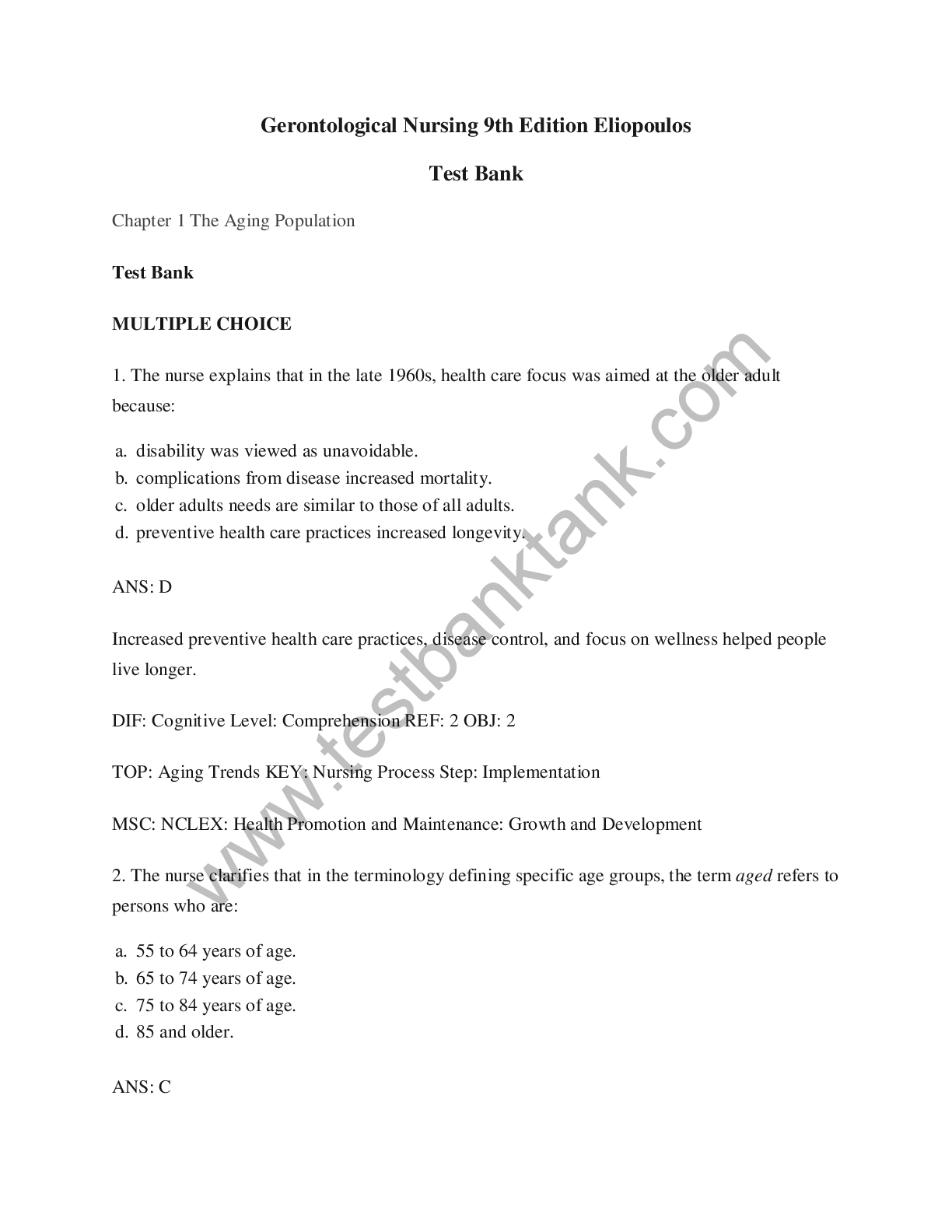
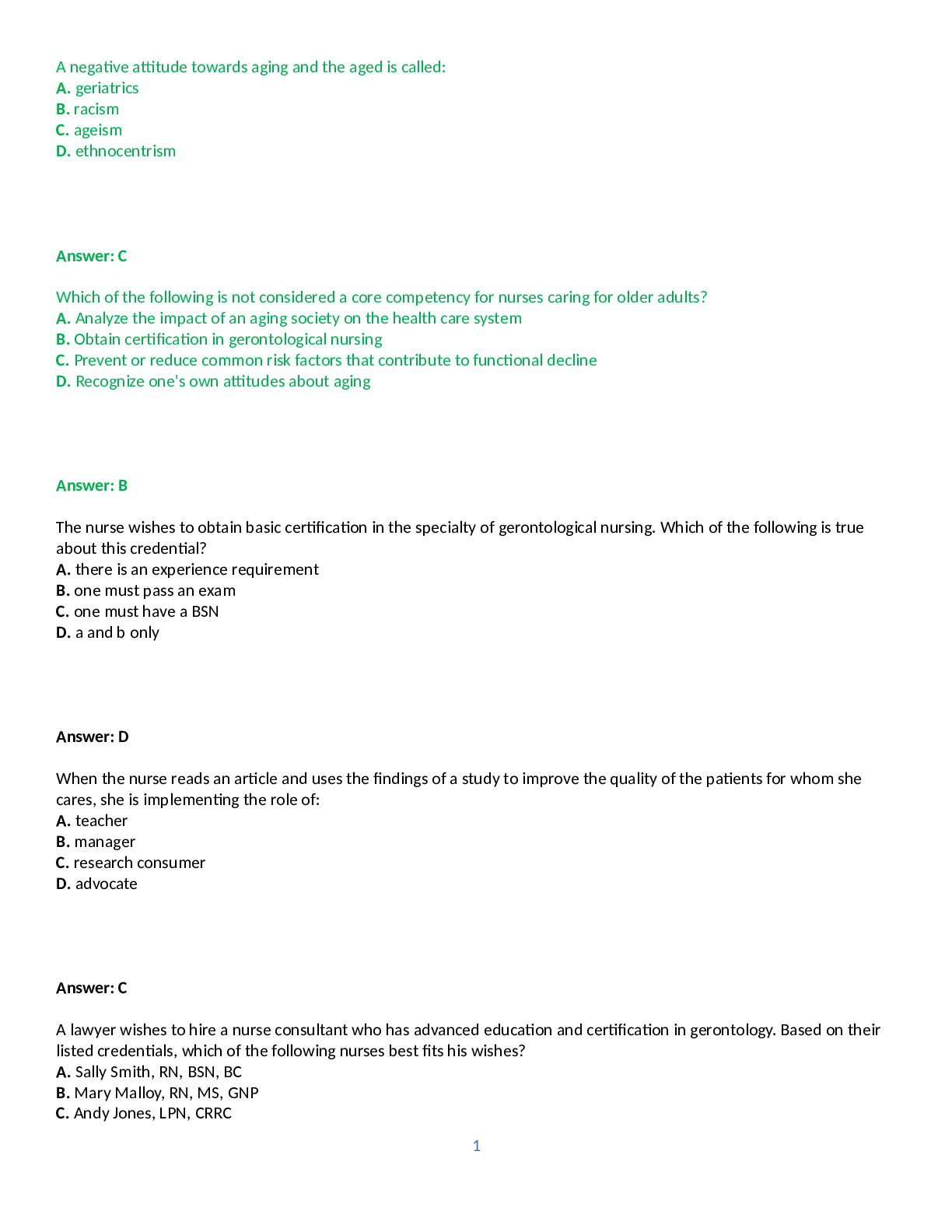
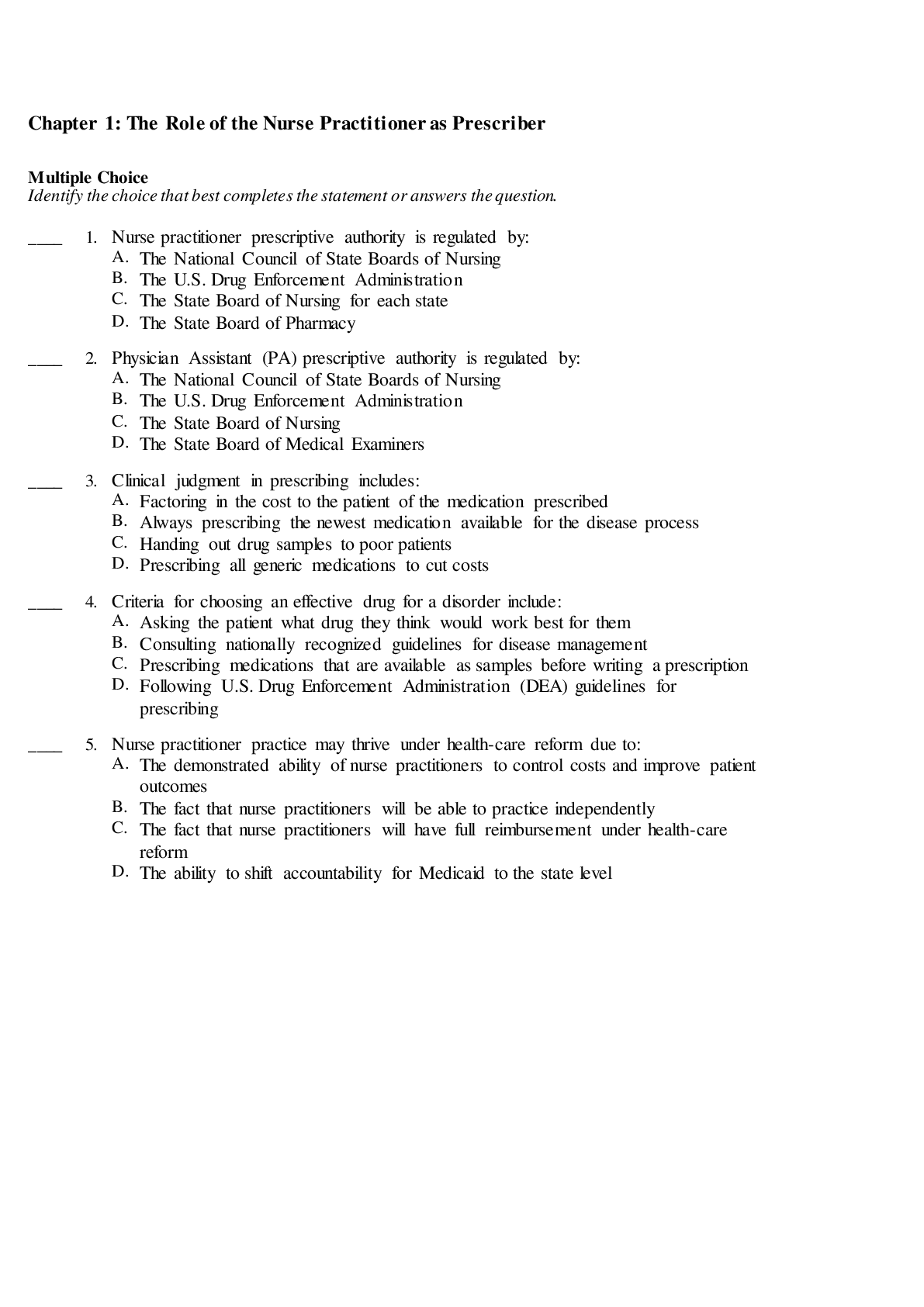
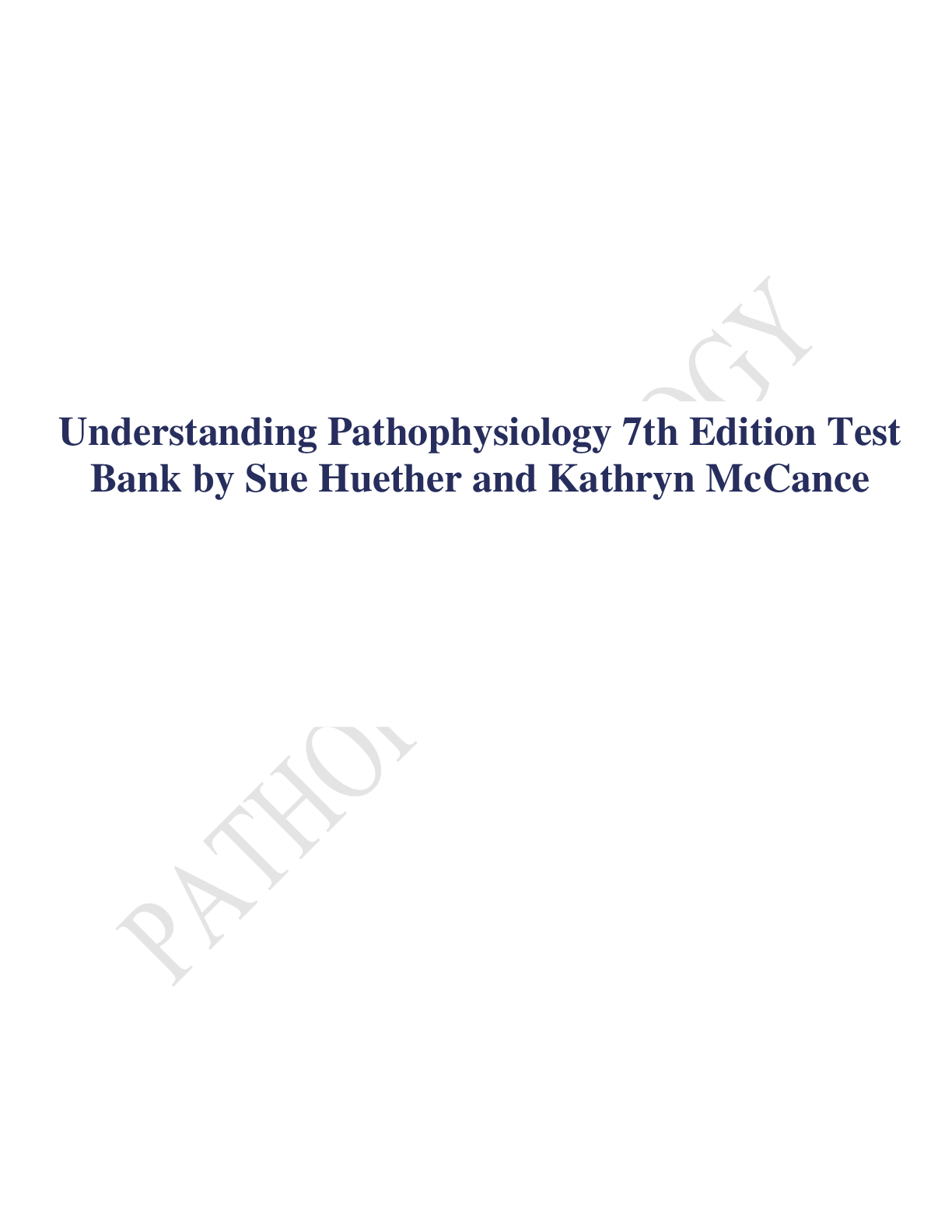
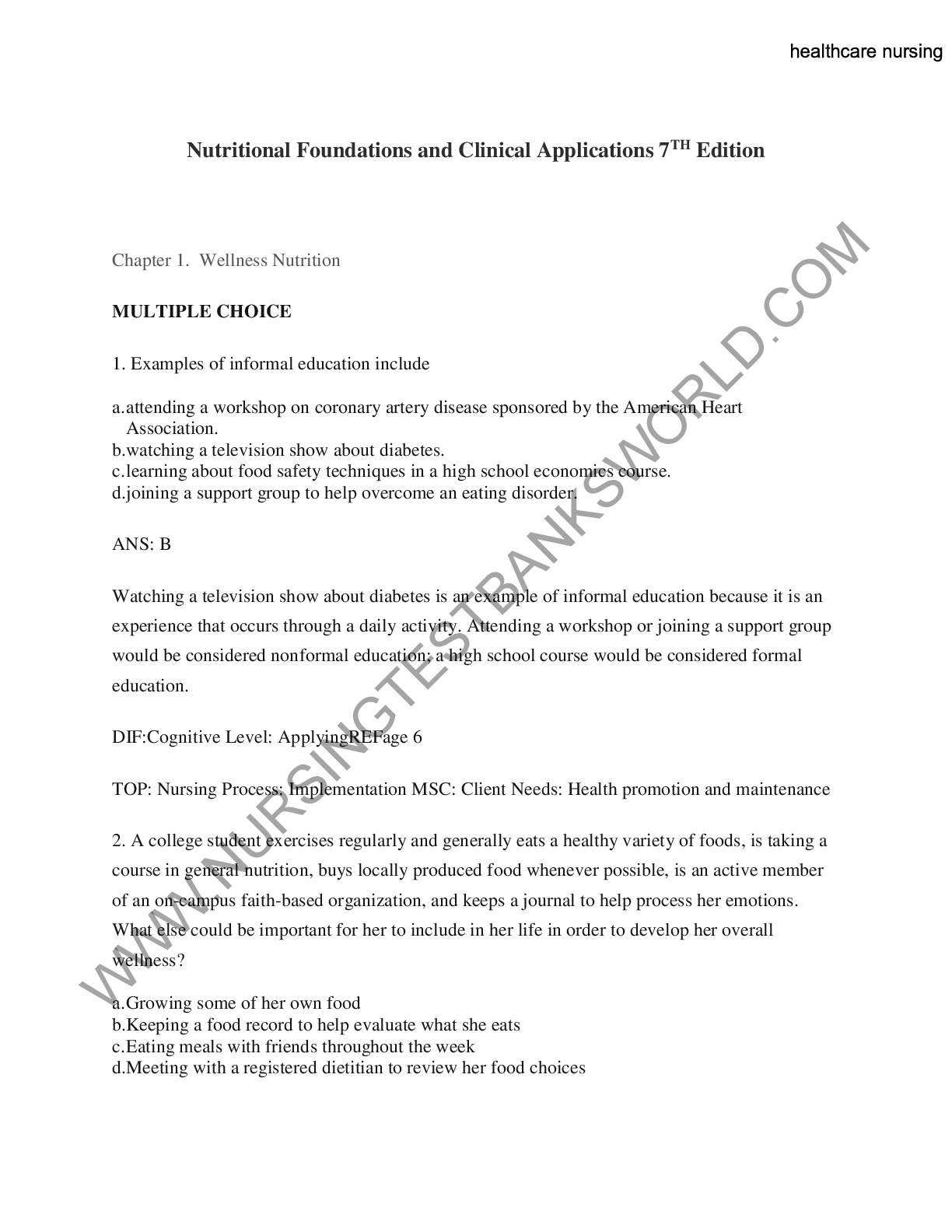
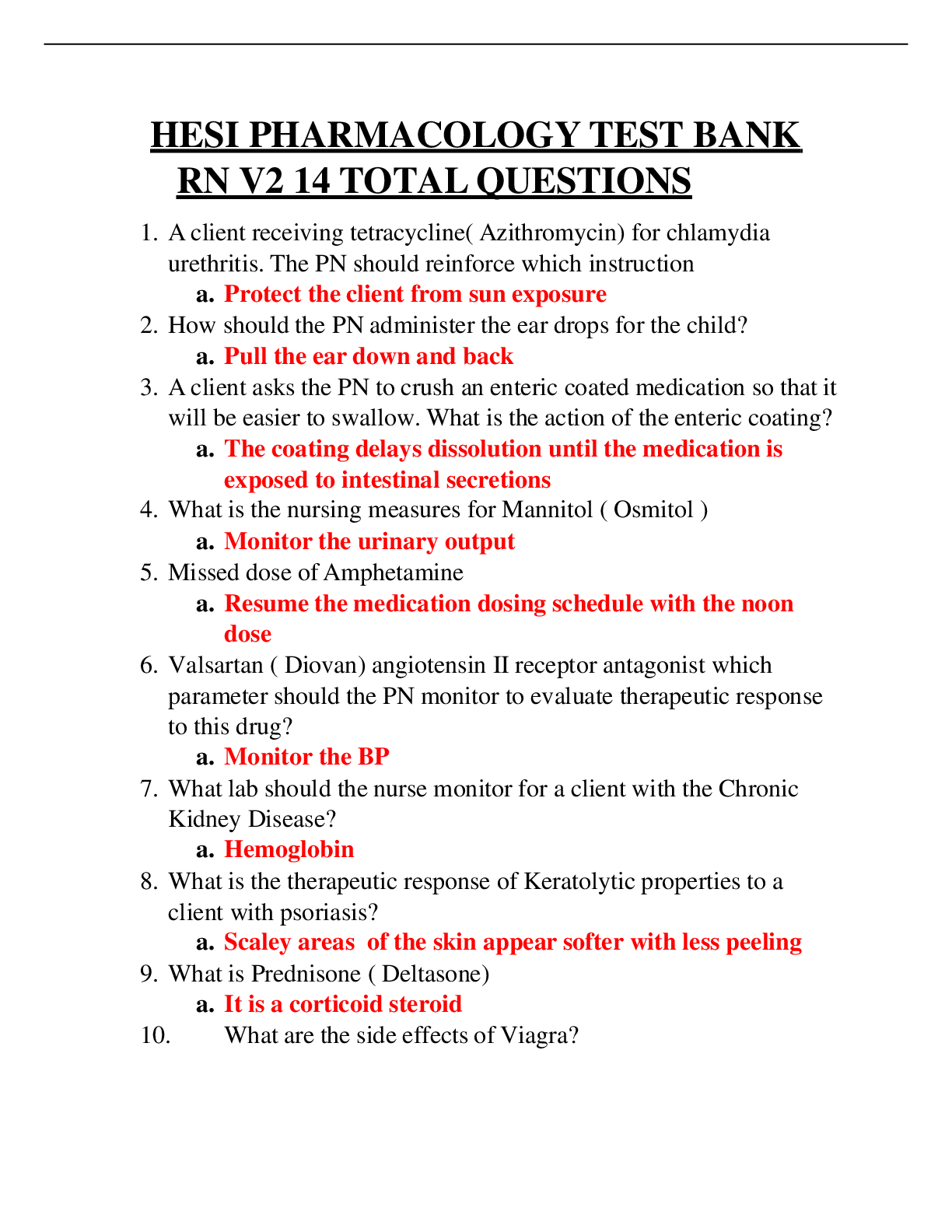
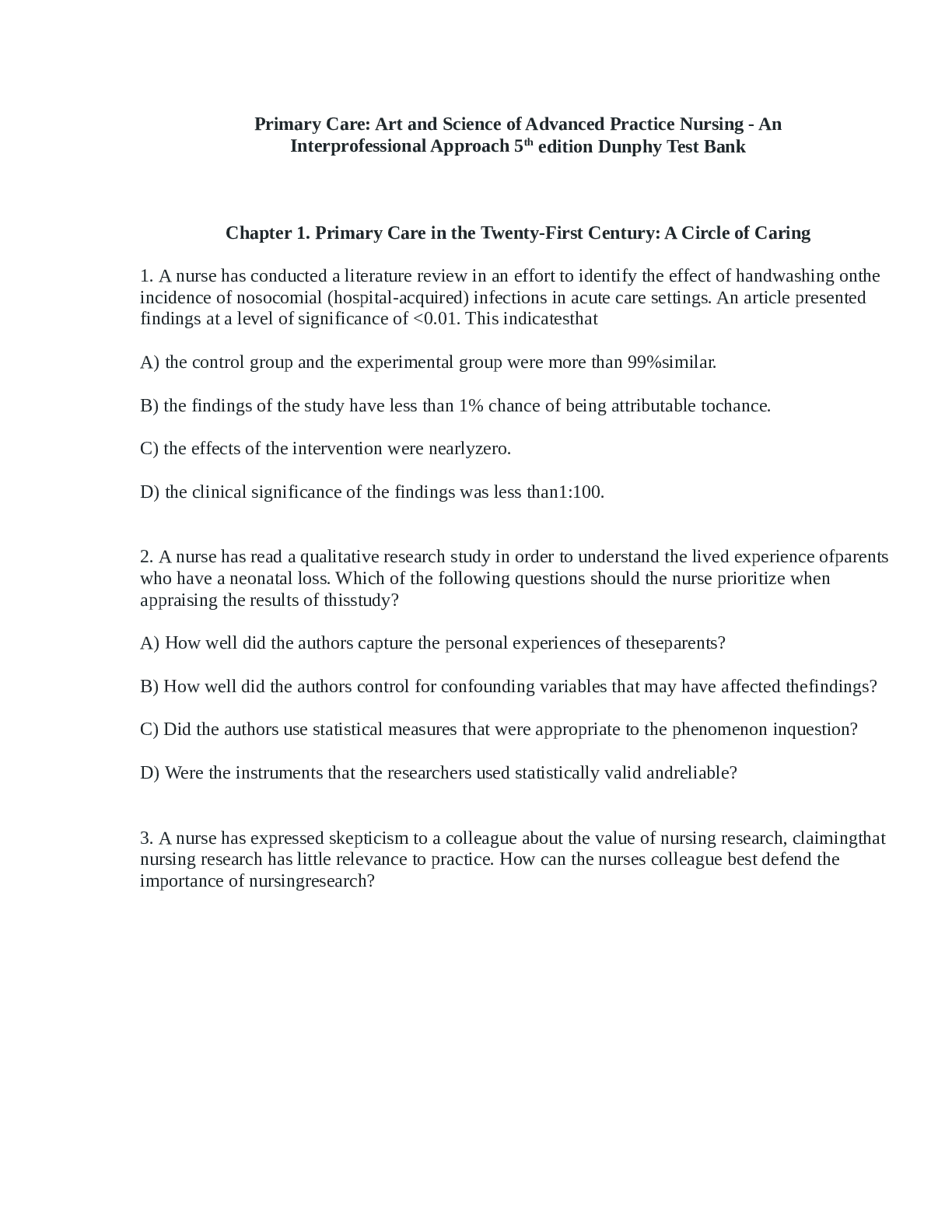
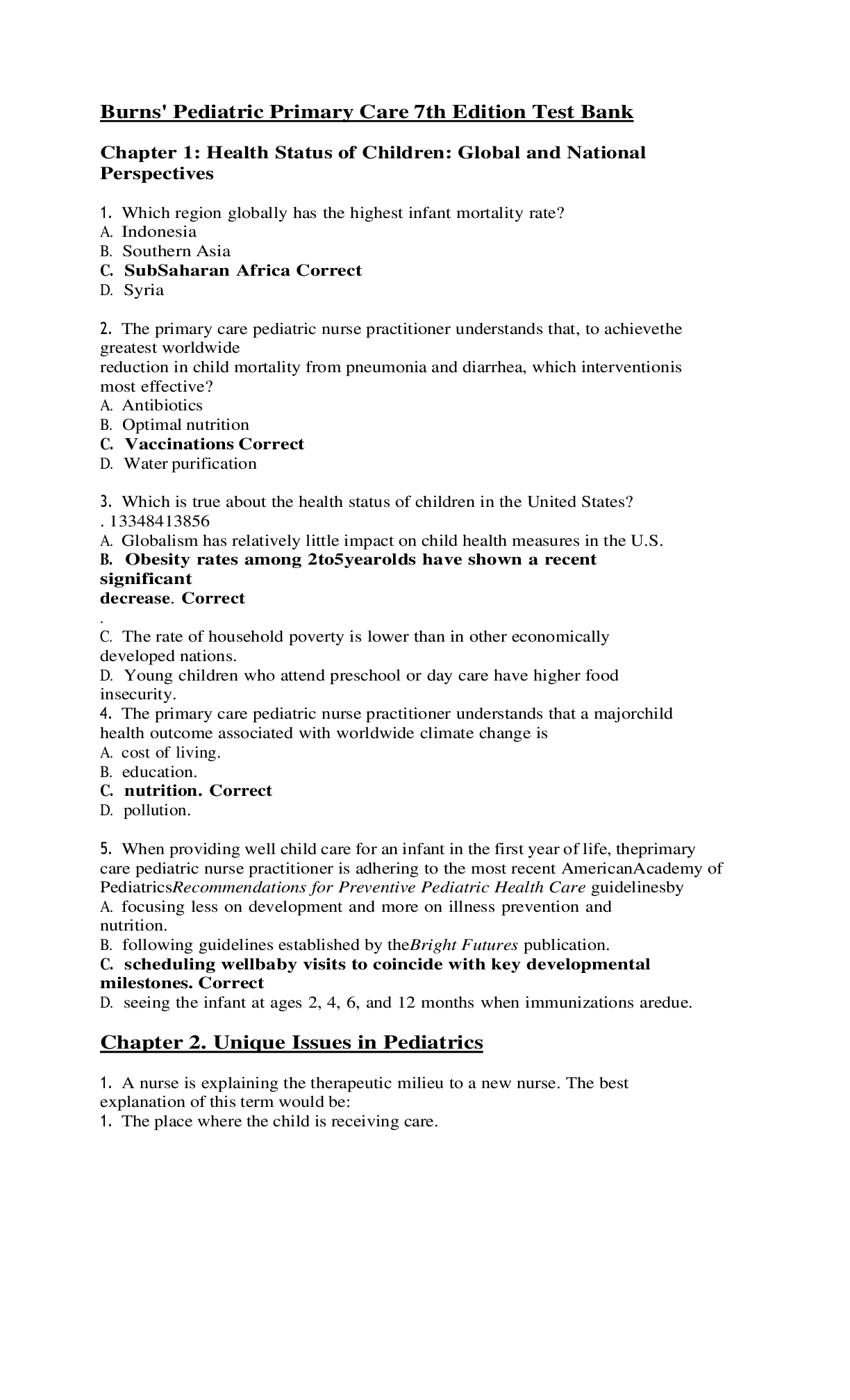
.png)

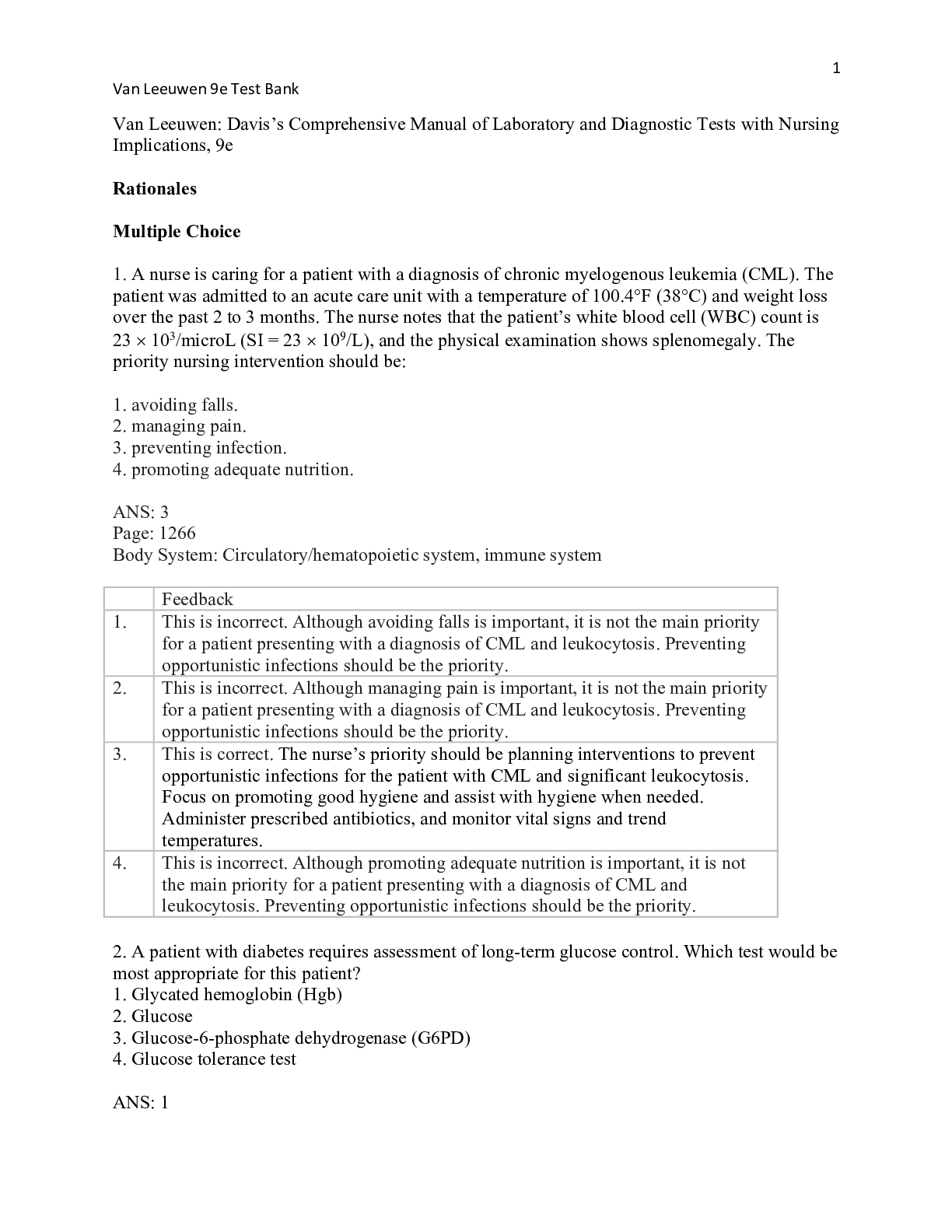
.png)


